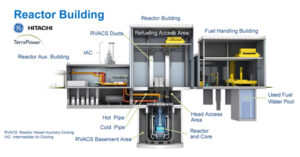
The U.S. Department of Energy is throwing a huge amount of tax payer money at so-called “advanced reactors,” hoping something will stick. Nothing so far looks promising but one project, the Natrium reactor, by TerraPower, claims to have started construction near Kemmerer, Wyoming. But really all they have done is some site clearing.
Meanwhile, the price tag for this sodium-cooled reactor, which has technical and proliferation concerns, just keeps climbing and has hit a whopping $9 billion for one unit. Expect that price to climb and for funding problems to develop.
In response to a Federal Register notice of June 12, 2024, various individuals and non-profit groups have submitted Environmental Impact Statement “scoping” comments to the Nuclear Regulator Commission, to be used as a basis for preparation of an EIS. You may ask a relevant question – how could the company begin site clear without an EIS having been completed? We ask that question, too.
Over a thousand individuals submitted scoping comments and below are links to some key comments by non-profit groups, submitted on the comment deadline of August 12, 2024. Though the NRC did not confirm to SRS Watch the receipt of our comments, as we requested, we were able to find them in the obtuse ADAMS document management system.
1. Tom Clements, SRS Watch: https://adamswebsearch2.nrc.gov/webSearch2/main.jsp?AccessionNumber=ML24226A041
2. Group sign-on comment led by Powder River Basin Resource Council (Wyoming): https://adamswebsearch2.nrc.gov/webSearch2/main.jsp?AccessionNumber=ML24226A046
3. Comments of the Union of Concerned Scientists (UCS) on the Scope of the Environmental Impact Assessment for the Kemmerer, Unit 1 Construction Permit Application NRC-2024-0078, Edwin S. Lyman, Director of Nuclear Power Safety: https://adamswebsearch2.nrc.gov/webSearch2/main.jsp?AccessionNumber=ML24226A029
As UCS says in the opening part of its comment the Natrium reactor poses risks:
The Kemmerer, Unit 1 project, a $9 billion+ sodium-cooled fast nuclear reactor, is something
that the world simply does not need. If it ever operates, which is highly unlikely, it will pose an
unacceptable menace to domestic and international safety and security. Unfortunately, due to the
incredibly poor judgment and lack of understanding of the project’s backers, including
TerraPower, which is being played for a patsy by a cadre of fast reactor enthusiasts within the
Department of Energy and its national lab system, it continues to move forward.
Fast reactors have numerous, fundamental design flaws which render them significantly more
dangerous than light-water reactors. However, TerraPower and other promoters of fast reactors
continue to disseminate dangerous misinformation about them, misleading policymakers and the
public about these risks. Consequently, it is incumbent on the NRC to fully discharge its statutory
responsibilities under NEPA and comprehensively assess the dire human health, environmental,
and security implications of the proposed action.
The Westinghouse AP1000 reactor project in South Carolina collapsed in 2017 and so far $11 billion has been spent on that debacle, with electricity customers set to pay about 5% of the monthly bill for another 15 years. And, the NuScale “small modular reactor” (SMR) project collapsed in November 2023.The Vogtle AP1000 project resulted in two AP1000 units going on line, with huge schedule delays and at a price tag of $37 billion. So, new nuclear reactors in the U.S. are proving to be bad business.
Place you bets on how long the Natrium project lasts and how much of our money and Bill Gates’ money will be wasted on it. (Yes, Bill Gates got hornswoggled into backing this project.)